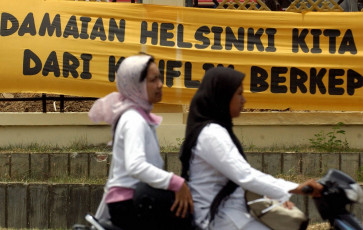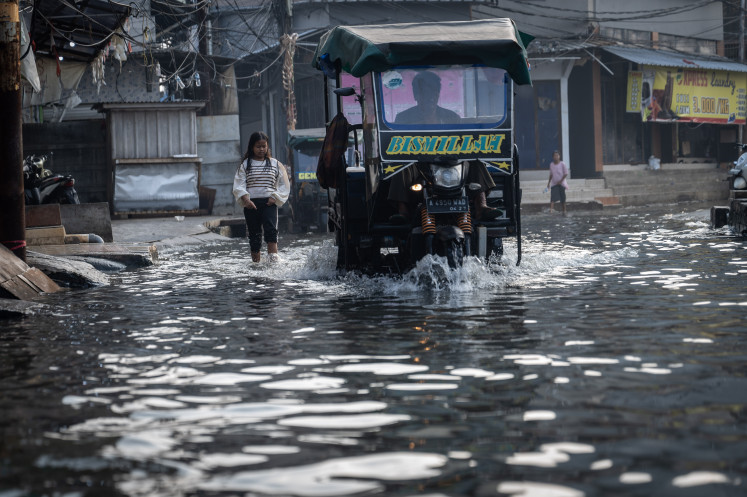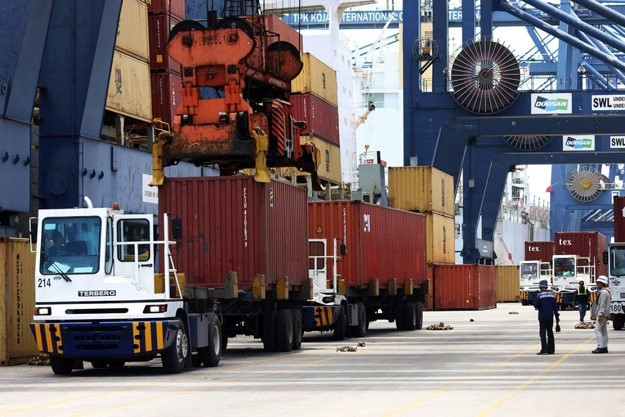Popular Reads
Top Results
Can't find what you're looking for?
View all search resultsPopular Reads
Top Results
Can't find what you're looking for?
View all search resultsIndonesia braces for more extreme rainy season
As the rainy season starts in several regions around the country, the government is bracing for possible hydrological disasters
Change text size
Gift Premium Articles
to Anyone

A
s the rainy season starts in several regions around the country, the government is bracing for possible hydrological disasters.
The rainy season is predicted to become more disastrous as climate change makes the weather more unpredictable.
The Meteorology, Climatology and Geophysics Agency (BMKG) said the rainy season would start in the first or second week of December and would reach its peak in February and March 2020.
“Increased awareness is needed during the peak season in January, February and March 2020, especially on the islands of Java, Bali, Nusa Tenggara, Sulawesi and Papua,” BMKG senior official Hary Djatmiko told The Jakarta Post on Wednesday.
An environmental group, the Indonesian Forum for the Environment (Walhi), said on Tuesday the pattern of hydrological disasters has evolved, with whirlwinds becoming more frequent and tropical cyclones creeping into Indonesia’s territory during the rainy season.
According to data from the National Disaster Mitigation Agency (BNPB), the number of hydrological disasters has steadily increased over the last 20 years.
Floods and landslide topped the list with 15,873 incidents that killed 7,081 people since 1999, according to the latest data, while combined hydrological disasters account for 98 percent of all disasters in Indonesia.
BNPB spokesman Agus Wibowo told the Post on Wednesday that global warming has made rainfall more severe during the rainy season.
“Environmental damages and possibly global warming make hydrological disasters more frequent. This year we reached the highest temperature of 38.8 degrees Celsius,” he said. “Extreme storms and rains are also increasing, which results in increasing numbers of floods, whirlwinds and landslides.”
The highest temperature was recorded by the Hasanuddin Meteorology Station in Makassar, South Sulawesi, on Oct. 20.
Based on the BNPB’s analysis, Agus said that the islands of Java and Sumatra are the most prone to disasters.
“If we’re talking about a region’s susceptibility to floods and landslides, we have to take population into the calculation. If a landslide occurred in a place where no-one lives, that’s not a problem, but if there are people and assets there, then it could be dangerous,” he said.
He said that based on the BNPB’s data, the provinces of Central, West and East Java are the top three regions with disasters. Central Java topped the list with 6,862 incidents since 1999.
“Java is particularly prone to disasters because of the sheer size of its population. If an area is flooded, then it would put many peoples’ lives in peril,” he said, adding that deforestation on the island has made the threats of flood and landslide worse.
To minimize the risk of casualties caused by natural disasters, the agency has rolled out efforts that focus on increasing people’s awareness of threats of natural disaster and establishing early warning systems (EWS) in disaster-prone regions.
“We have a disaster mapping program, INARISK, which is publicly available and early warning system equipment that has been installed in several regions. We have also established village quick response teams and rely on the commitments of local administrations,” he said.
While he could not elaborate on the number of areas covered by the EWS equipment, he said its presence is still low in all regions.
In the cities of Semarang, Bandung and Greater Jakarta, the BNPB has also been working with Qlue, Twitter and detik.com in creating a website called petabencana.id to monitor floods based on citizens’ reports.
The disaster agency is also trying to increase public knowledge about the threats of natural disasters in their respective regions through initiatives called Desa Tangguh Bencana (Disaster Resilient Village) and Keluarga Tangguh Bencana (Disaster Resilient Family).
The Keluarga Tangguh Bencana program, which takes the form of an online course accessed at indonesiax.co.id, has been visited by more than 2,000 people since April, Agus claimed.
To fund its mitigation efforts, the BNPB obtained a budget of Rp 600 billion (US$42 million) in 2019, with an additional Rp 4 trillion ($283 million) of funds that could be used when a region or a province declares a state of emergency.
The agency as a coordinating body also regularly communicates with all regional disaster mitigation agencies, Agus said.(mpr)









